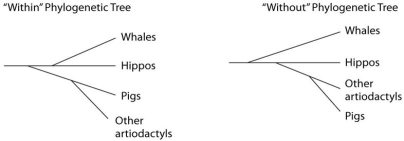Multiple Choice
Use the following information and figure to answer the questions below.
Traditionally, whales and hippopotamuses have been classified in different orders, the Cetacea and the Artiodactyla, respectively. Recent molecular evidence, however, indicates that the whales' closest living relatives are the hippos. This has caused some zoologists to lump the two orders together into a single clade, the Cetartiodactyla. There is no consensus on whether the Cetartiodactyla should be accorded order status or superorder status. This is because it remains unclear whether the whale lineage diverged from the lineage leading to the hippos before or after the other members of the order Artiodactyla (pigs, camels, etc.) diverged (see the figure below) .

This figure contrasts the "Within the artiodactyls" origin of the whale lineage with the "Without the artiodactyls" origin of the whale lineage.
-Placing whales and hippos in the same clade means
A) that these organisms are phenotypically more similar to each other than to any others shown on the trees in the above figure.
B) that their morphological similarities are probably homoplasies.
C) that they had a common ancestor.
D) that all three of the responses are correct.
E) that two of the responses are correct.
Correct Answer:

Verified
Correct Answer:
Verified
Q12: Which kingdom has been replaced with two
Q16: When using a cladistic approach to systematics,
Q43: Which eukaryotic kingdom includes members that are
Q44: If, someday, an archaean cell is discovered
Q46: The following questions refer to this phylogenetic
Q50: Which statement represents the best explanation for
Q53: A large proportion of archaeans are extremophiles,
Q57: Assuming chimps and gorillas are humans' closest
Q67: Concerning growth in genome size over evolutionary
Q67: If you were using cladistics to build